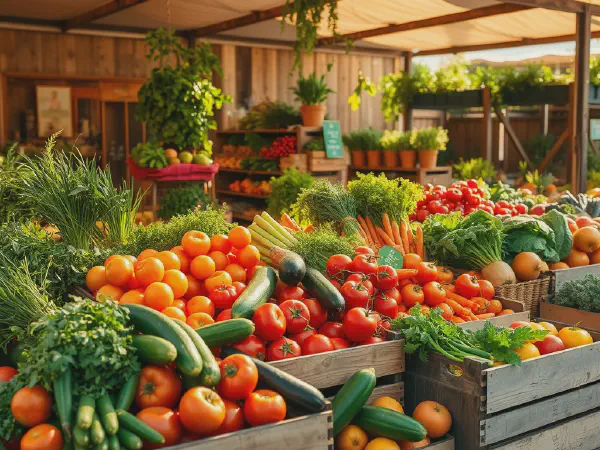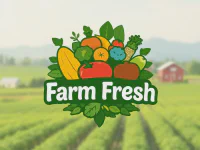Expert Tips on How to Choose the Best Farm-Fresh Produce

Choosing Farm-Fresh Produce
Choosing Farm-Fresh Produce is essential for anyone looking to enjoy the best flavors and nutritional benefits that fruits and vegetables have to offer. When you select produce that is harvested at its peak ripeness, you not only savor the taste but also increase your intake of essential vitamins and minerals. Fresh produce supports a healthy diet and contributes to overall well-being.
Moreover, Choosing Farm-Fresh Produce helps to support local economies and sustainable farming practices. By purchasing directly from farmers, consumers can reduce the carbon footprint associated with transporting goods while also contributing to the livelihoods of local growers. Knowing where your food comes from fosters a deeper relationship with the food community and promotes a healthier environment.
In addition to the ethical and nutritional reasons, Choosing Farm-Fresh Produce means enjoying a more vibrant and colorful plate. Seasonal fruits and vegetables offer a range of flavors that vary throughout the year, encouraging variety in your meals. It’s an opportunity to experiment with new recipes and explore different cooking techniques while using the freshest ingredients possible.
However, it can be challenging to know what to look for when shopping for farm-fresh produce. Understanding how to assess freshness, ripeness, and local practices is key to making informed choices. This guide aims to provide you with the essential tips and knowledge needed for successfully choosing the best farm-fresh produce available in your area.
As you embark on the journey of Choosing Farm-Fresh Produce, keep in mind the importance of supporting seasonal, local, and sustainable farming practices for your health and the health of the planet.
Understanding Seasonal Produce
Eating seasonally not only enhances your diet but is also beneficial for local ecosystems. Seasonal fruits and vegetables have grown in harmony with their environment, getting the right nutrients and flavor from the soil, water, and sun at the precise times they need it. This means they often carry more vitamins and minerals, making them healthier options for consumption.
To identify seasonal produce at local markets, pay attention to what’s being highlighted by farmers. Farmers often provide the freshest produce available, selling items that are harvested in the current season. Additionally, consult local guides or apps that showcase seasonal fruits and vegetables to help you make informed choices based on what’s in season in your area.
The impact of seasonality on flavor and nutrition cannot be overstated. Produce that is allowed to ripen naturally on the plant develops more flavor and higher nutrient content. Off-season produce, often grown in greenhouses or shipped long distances, may not have the same taste or nutrition, making it worthwhile to prioritize seasonal selections when shopping.
Visual and Textural Cues
When it comes to assessing the freshness of fruits and vegetables, visual and textural cues are essential. Fresh produce typically has vibrant colors and firm textures. Dull or faded colors can be signs of older or less fresh produce, while wilted greens indicate a lack of freshness and vitality.
Indicators of ripeness vary among fruit and vegetable types. For instance, a ripe avocado should yield slightly to pressure, while a tomato should feel firm yet slightly soft at the stem end. Recognizing these different indicators for every type of produce allows consumers to choose the most suitable items for their needs.
Common visual imperfections often indicate the age or quality of produce. Minor blemishes or spots are not always a bad sign and can sometimes affect flavor more than nutrition. However, large bruises or mold are indications to avoid those items. Learning to distinguish between acceptable and unacceptable imperfections is helpful for making better choices at the market.
Local vs. Organic Produce
While both local and organic produce have their merits, it's crucial to understand the differences between local and organic labeling. Local produce refers to items grown in the nearby areas, while organic produce is grown without synthetic fertilizers and pesticides. It's possible to find local produce that is not organic and vice versa. Each holds advantages concerning sustainability and environmental impact.
Assessing local farm practices involves learning about how they cultivate, harvest, and sell their produce. Farmers markets are perfect venues to chat with producers about their farming methods. Many local farmers are happy to explain their techniques, which helps establish trust and gives you peace of mind knowing where your food comes from.
Supporting local farmers provides significant benefits to the community. Local farming contributes to the economy, promotes biodiversity, and often employs more sustainable farming practices. By choosing local over large-scale commercial agriculture, consumers help sustain the agricultural landscape and support their neighbors.
Storage and Handling Tips
To keep your fresh produce at its best, it is important to follow best practices for storing fresh fruits and vegetables. Many produce items store better in the fridge, while others do not. For instance, tomatoes and avocados should be kept at room temperature, while leafy greens and berries thrive in cold conditions. Proper humidity levels also play a role in storage longevity.
Extending the shelf life of fruits and vegetables can be accomplished by storing them in the right conditions and utilizing techniques like wrapping them in breathable materials or utilizing produce drawers in your refrigerator. Additionally, freezing excess produce is a great way to preserve the nutritional benefits for later use while reducing waste.
Signs of spoilage vary among different produce types. For example, slimy textures or strong odors indicate spoiled leafy greens, while discoloration and a mushy texture can signify that tomatoes or peppers have gone bad. Being vigilant about these signs can help you utilize your produce at its best quality.
Buying in Bulk vs. Small Quantities
Buying in bulk has notable advantages, including cost savings and reduced packaging waste. However, it also comes with disadvantages, such as the risk of spoilage if not consumed quickly. Understanding your consumption habits is vital when deciding whether to buy in bulk to avoid waste while maximizing savings.
Planning your purchases becomes essential when reducing waste, especially if you choose to buy in bulk. Creating meal plans, and using grocery lists can help you avoid over-purchasing and ensure that you consume the items before they spoil. This strategy also fosters creativity in the kitchen, allowing you to experiment with various recipes using the same ingredients.
Sharing bulk produce with others is another effective strategy. Partnering with friends, family, or neighbors can make it easier to purchase larger quantities without the worry of waste. Organizing produce swaps or community share programs creates a sense of community and encourages sustainable practices.
